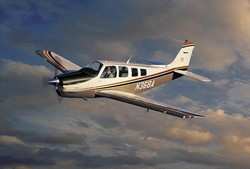STC Granted To CAV Aerospace For FIKI System
An amended STC approval from the FAA has been granted to CAV
Aerospace to install the TKS Flight Into Known Icing (FIKI)
protection system in Bonanza G36 aircraft. The company is
scheduling installation of the proprietary TKS system in Bonanza
G36s for a base price of $47,500.

Bonanza G36
"We've been working towards obtaining FIKI approval for the G36
for a while and with more than 300 other Bonanza aircraft
previously flying the TKS system, we have already integrated the
work into our routine installation schedules," said CAV Aerospace
President Kevin Hawley. The Bonanza G36 approval is an amendment to
the STC that CAV Aerospace holds for the Bonanza A36 for flight
into known icing. "Known ice protection through CAV's TKS system
boosts Bonanza G36 capability and gives owners additional peace of
mind," Hawley said. "Our system makes a classic high performance
aircraft even more flexible. No other ice protection system,
including boots or electrical heating systems, can provide the same
level of protection as TKS," said Hawley. "TKS gives complete
airframe protection for the wings, tail surfaces, propeller, and
windshield."
The company says there is virtually no loss in aircraft
performance as a result of installing the TKS system. The TKS
system weighs only 51 lbs. without fluid (lighter than a boot
system) and 115.4 lbs. with a full tank of fluid. A full tank of
ice protection fluid provides up to 2.5 hours of continuous ice
protection. As the system is used, it flushes out any accumulation
of debris on the panels. Glycol, the main ingredient in the ice
protection fluid, has cleaning properties and will not harm the
paint finish of the aircraft.

NASA has documented the effectiveness of the TKS ice protection
concept through extensive testing in the icing research tunnel at
the Lewis Research Center. Hawker Beechcraft's Hawker series of
mid-size business jets has used TKS ice protection as standard
equipment for decades. The Bonanza G36 TKS flight into known icing
system offers pilots more time to make crucial decisions when
encountering icing conditions. Even with a flight into known icing
TKS system, one should always take immediate steps to exit icing
conditions should they be encountered.
Laser-drilled titanium panels are installed on the leading edges
of the wings, horizontal and vertical stabilizers. A slinger
ring is installed on the propeller and a spray bar is positioned in
front of the windshield for protection. A glycol-based fluid is
pumped through the panels at a low rate. The fluid flows over the
protected surfaces and keeps the aircraft virtually ice-free. The
glycol-based fluid is pumped from a tank by individually selectable
metering pumps, through a microfilter to proportioning units.
The proportioning units contain calibrated capillary tubes, which
divide the flow to the individual needs of the porous panels and
the slinger ring. The windshield is also protected by two on-demand
pumps. Either pump will supply fluid to the spray bar for
windshield ice protection.
CAV Aerospace says that a significant advantage to the pilot is
the simple operation of the system. Just turn the system "ON" when
icing is encountered and "OFF" when leaving the icing condition.
Only one choice of operation exists for the pilot when using the
system: NORMAL or MAXIMUM mode. Using the NORMAL mode in typical
icing conditions, a protective film of glycol prevents the
formation of ice. In heavier icing conditions or cases of
accumulated ice, the MAXIMUM mode increases the system flow rate to
shed ice. A significant feature of both modes is the elimination of
runback ice.
 NTSB Prelim: Piper PA-23
NTSB Prelim: Piper PA-23 Classic Aero-TV: One Mans Vietnam
Classic Aero-TV: One Mans Vietnam NTSB Final Report: Capella Aircraft Corp FW1C50
NTSB Final Report: Capella Aircraft Corp FW1C50 Classic Aero-TV: Timber Tiger Touts Curtiss Jenny Replicas
Classic Aero-TV: Timber Tiger Touts Curtiss Jenny Replicas ANN's Daily Aero-Term (07.04.25): Performance-Based Navigation (PBN) [ICAO]
ANN's Daily Aero-Term (07.04.25): Performance-Based Navigation (PBN) [ICAO]




